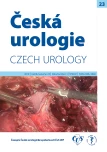Diagnosis, therapy and urological complications of cloacal malformations
Authors:
Jan Trachta 1; Martin Kynčl 2; Richard Škába 1
Authors‘ workplace:
Klinika dětské chirurgie 2. LF UK a FN Motol, Praha
1; Klinika zobrazovacích metod 2. LF UK a FN Motol, Praha
2
Published in:
Ces Urol 2019; 23(1): 19-29
Category:
Review article
Overview
Major Statement: A review article about the diagnostic tools and management of persistent cloaca malformation that belongs to one of the most complex new-born anomalies with a need of the life-long follow-up by pediatric and general urologist. The majority of cloaca patients undergo multiple reconstructive procedures.
Cloacal malformation is the most severe form of anorectal malformation in girls. The complex treatment is possible only in specialized pediatric centers and life-long follow-up is needed. Females with persistent cloaca suffer also from many associ‑ated anomalies, especially urinary tract and spinal malformations. Correct anatomical and functional reconstruction of persistent cloaca belongs to one of the most challenging tasks in pediatric surgery and urology. The goal of the complex therapy is to help patients achieve urinary and fecal continence, regu‑lar menstruation at puberty and possibility of good quality of sexual life in adulthood. In this review article based on the current literature and our own experi‑ence we describe the spectrum of cloaca malforma‑tions and associated anomalies, possible techniques of reconstruction and expected outcomes after the treatment by multiple specialist team. For achieving urinary continence these patients often need several urology procedures. However, despite the complex treatment half of the cloaca girls will develop chronic kidney disease before achieving adulthood and there‑fore detailed and long-term follow-up by dedicated pediatric and general urologist is mandatory.
Keywords:
Cloacal malformation – hydrocolpos – mobilisation of urogenital sinus.
Sources
- Šnajdauf J, Škába R. Dětská chirurgie. 1. vydání. Praha Galén 2005; 11–18.
- Warne SA, Wilcox DT, Ransley PG. Long‑term urological outcome of patients presenting with persistent cloaca. J Urol 2002; 168 : 1859–1862.
- Rink RC, Herndon CD, Cain MP, et al. Upper and lower urinary tract outcome after surgical repair of cloacal malformations: a three‑decade experience. BJU Int. 2005; 96(1): 131–134.
- Fernando MA, Creighton SM, Wood D. The long‑term management and outcomes of cloacal anomalies. Pediatr Nephrol. 2015; 30(5): 759–765.
- Levitt MA, Peña A. Cloacal malformations: lessons learned from 490 cases. Semin Pediatr Surg. 2010; 19(2): 128–138.
- Qi BQ, Williams A, Beasley S, et al. Clarification of the process of separation of the cloaca into rectum and urogenital sinus in the rat embryo. J Pediatr Surg 2000; 35 : 1810–1816.
- Cilento BG, Jr, Benacerraf BR, Mandell J. Prenatal diagnosis of cloacal malformation. Urology 1994; 43 : 386–388.
- Warne SA, Hiorns MP, Curry J, Mushtaq I. Understanding cloacal anomalies. Arch Dis Child. 2011; 96(11): 1072–1076.
- Rink R. Surgical management of disorders od sex development and cloaca and anorectal malformations.CambellWalsh ‑ Urology, 11th ed., Philadelphia, PA: Elsevier/Saunders 2016; 3498–3520.
- VanderBrink BA, Reddy PP. Early urologic considerations in patients with persistent cloaca. Semin Pediatr Surg. 2016; 25(2): 82–89.
- Peña A, Levitt MA. Imperforate anus and cloacal malformations. In: Ashcraft KW, Holcomb GW, Murphy JP, eds. Pediatric Surgery. 4th ed. Philadelphia, PA: Elsevier Saunders 2005 : 496–517.
- Levitt MA, Peña A. Pitfalls in the management of newborn cloacas. Pediatr Surg Int 2005; 21 : 264–269.
- Lee JH, Zhang J, Wei L, Yu SP. Neurodevelopmental implications of the general anesthesia in neonate and infants. Exp Neurol. 2015; 272 : 50–60.
- Armstrong R, Xu F, Arora A, Rasic N, Syed NI. General anesthetics and cytotoxicity: possible implica‑tions for brain health. Drug Chem Toxicol. 2017; 40(2): 241–249.
- Raffensperger JG, Ramenofsky ML. The management of cloaca. J Pediatr Surg. 1973; 8 : 647–657.
- Hendren WH. Further experience in reconstructive surgery for cloacal anomalies. J Pediatr Surg 1982; 17 : 695–717.
- Peña A, Devries PA. Posterior sagittal anorectoplasty: important technical considerations and new applications. J Pediatr Surg. 1982; 17(6): 796–811.
- Peña A. The surgical management of persistent cloaca: results in 54 patients treated with a posterior sagittal approach. J Pediatr Surg 1989; 24 : 590–598.
- Peña A. Total urogenital mobilization-an easier way to repair cloacas. J Pediatr Surg. 1997; 32(2): 263–267.
- Peña A, Levitt MA, Hong A, Midulla P. Surgical management of cloacal malformations: a review of
- patients. J Pediatr Surg. 2004; 39(3): 470–479.
- Elder JS, Pippi‑Salle JL. Bladder outlet surgery for congenital incontinence. In: Gearhart, Rink, Mou‑riquand: Pediatric Urology, 2nd ed., Elsevier 2005; 761–773.
- Hendren WH. Cloaca, the most severe degree of imperforate anus: experience with 195 cases. Ann Surg 1998; 228 : 331–346.
- Peña A. Anorectal malformations. Semin Pediatr Surg 1995; 4 : 35–47.
- WarneSA, Godley ML, Wilcox DT. Surgical reconstruction of cloacal malformation can alter bladder function: a comparative study with anorectal anomalies. J Urol 2004; 172 : 2377–2381.
- Yerkes YB, Rink R. Surgical management of female genital anomalies, disorders of sex development, urogenital sinus, and cloaca anomalies. In: Gearhart, Rink, Mouriquand: Pediatric Urology, 2nd ed., Elsevier 2005; 476–499.
- Warne SA, Wilcox DT, Creighton S, et al. Long‑term gynecological outcome of patients with persistent cloaca. J Urol 2003; 170 : 1493–1496.
Labels
Paediatric urologist Nephrology UrologyArticle was published in
Czech Urology

2019 Issue 1
Most read in this issue
- Endometriosis of the bladder as a cause of iatrogenic bladder perforation
- Use of PSA density and multiparametric MRI for indication of prostate biopsy
- A urologists view of hematuria in pediatric patients
- Diagnosis, therapy and urological complications of cloacal malformations
